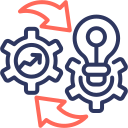Cloud Migration Best Practices
Effective cloud migration is essential for organizations aiming to stay competitive in the digital era. It requires meticulous planning, technical expertise, and a focus on overall business objectives to ensure a smooth transition. By following proven best practices, businesses can maximize the value of their cloud investments, minimize disruptions, and optimize their operations for scalability, security, and agility. The following sections detail strategic approaches and considerations, offering a comprehensive guide to successful cloud migration for organizations of all sizes and industries.

Inventorying Existing Assets
Before migrating to the cloud, it is crucial to create a thorough inventory of all company assets, including applications, databases, storage systems, and network components. Understanding the existing environment allows teams to identify legacy systems, dependencies, and performance characteristics. This step helps in determining which components can move to the cloud as-is, which require modernization, and which might need to be retired. In-depth inventorying also minimizes the risk of overlooking critical systems and ensures no business functionality is left behind during migration, supporting better resource allocation and project planning.
Defining Migration Objectives
Clear objectives must be established to guide the migration process and measure its success. Organizations should specify what they aim to achieve by moving to the cloud, such as improved scalability, enhanced security, cost savings, or business continuity. Defining objectives allows stakeholders to stay focused and make informed decisions when selecting migration strategies and cloud providers. Well-defined goals also facilitate effective communication across teams, ensuring everyone understands the intended outcomes and can work collaboratively to achieve them.
Risk Assessment and Mitigation Strategy
Identifying potential risks, such as data loss, downtime, application incompatibility, and security breaches, is a vital part of the migration planning phase. Developing mitigation strategies for each identified risk helps to proactively address issues before they impact the migration. This involves preparing backup plans, disaster recovery procedures, and rollback options. Proactive risk management ensures business continuity throughout the migration process and provides confidence to stakeholders that challenges are anticipated and will be effectively managed.
Selecting the Right Cloud Model and Provider
Evaluating Cloud Service Models
Organizations must decide between Infrastructure as a Service (IaaS), Platform as a Service (PaaS), and Software as a Service (SaaS) based on their workload requirements and IT maturity. Each model offers varying levels of control, flexibility, and management responsibility. A thorough evaluation helps organizations balance cost, operational complexity, and agility while ensuring compatibility with existing applications. Selecting the right service model streamlines migration and maximizes the benefits obtained from the cloud.

Comparing Cloud Providers
Choosing the right cloud provider—such as AWS, Azure, Google Cloud, or smaller niche vendors—involves comparing features, pricing, support offerings, and service-level agreements. Organizations should assess each provider’s strengths in security, compliance, scalability, and integration capabilities with other enterprise tools. It is also important to consider the provider’s track record for uptime, technical support, and ongoing innovation. By making an informed choice, businesses ensure they have a reliable partner for both migration and future growth.
Application and Data Readiness
01
Mapping out all application dependencies—including databases, third-party integrations, and supporting services—is essential for minimizing migration risks. Understanding interdependencies helps prioritize workloads and manage cutover sequencing more effectively. It also reveals potential bottlenecks or compatibility issues that could arise after migration. Organizations can use this insight to develop targeted migration paths that preserve business continuity while minimizing operational disruptions.
02
Before transferring data to the cloud, it is important to classify it based on sensitivity, criticality, and compliance requirements. Data cleansing—removing duplicate or outdated records—improves data quality and reduces storage costs. Proper classification also enables organizations to implement the right security controls in alignment with company and regulatory policies. Effective preparation of data ensures smoother migration, better performance, and compliance in the new cloud environment.
03
Legacy applications may not always be cloud-ready or able to leverage cloud-native features. Refactoring involves redesigning parts of an application for better performance and scalability in the cloud, while modernization might include adopting containerization or microservices. Although initially time-intensive, these efforts yield long-term benefits such as improved reliability, lower operational costs, and enhanced agility. Prioritizing application readiness fosters seamless transitions and maximizes value post-migration.

Protecting data throughout the migration process requires implementing strong encryption protocols both when data is being transferred and when it is stored in the cloud. Secure key management, access controls, and audit trails are essential to comply with legal and contractual obligations. Businesses must work closely with cloud providers to understand shared responsibility models, ensuring that all data is continuously safeguarded against unauthorized access or breaches.

Strong identity and access management (IAM) frameworks help control who can access which resources in the cloud environment. Granular permissions, multi-factor authentication, and regular access reviews reduce the risk of insider threats and accidental exposures. Companies should establish IAM policies during planning and incorporate least-privilege principles for sensitive systems. Mature IAM practices are vital components in any cloud security strategy, supporting ongoing compliance and operational integrity.

Adopting automated monitoring tools and compliance management platforms is critical for identifying vulnerabilities and demonstrating adherence to required standards. These tools enable organizations to detect anomalous activities in real time and automate auditing processes. Continuous compliance tracking provides actionable insights for remediating risks swiftly, while frequent reporting demonstrates accountability to auditors and stakeholders, preventing costly lapses in regulatory conformance.
Phased and Controlled Migration Approach
Launching a pilot or proof-of-concept sets the migration project on a path of validated learning before committing to full deployment. Selecting a small, non-critical workload for initial migration allows teams to test tooling, processes, and integration points in a low-risk environment. Feedback and lessons learned from the pilot inform adjustments to strategy, guide resource allocation, and help develop standardized templates or processes for later stages, ultimately increasing the success rate of broader migrations.
Performance Optimization and Cost Management
01
Resource Right-Sizing
Adjusting cloud resources to match actual workload requirements prevents overprovisioning and unnecessary spending. Right-sizing involves monitoring usage patterns and scaling virtual machines, storage, or services to align with real-time demand. This optimization leads to improved performance, lower costs, and a more agile environment able to respond to business needs. Automated tools can further simplify resource management by providing recommendations and triggering scale adjustments as needed.
02
Implementing Cost Controls
Cloud environments can quickly accrue costs if left unmonitored. Setting spending limits, implementing tagging strategies for cost allocation, and regularly reviewing billing reports are crucial practices. In addition to monitoring expenditure, leveraging reserved instances or spot pricing can yield additional savings. Cost control mechanisms ensure financial accountability and help organizations maximize the return on investment from their cloud initiatives.
03
Monitoring Performance Metrics
Continuous performance monitoring enables organizations to measure application responsiveness, system availability, and user experience in the cloud. Setting up dashboards and automated alerts helps identify performance bottlenecks, system downtimes, or capacity constraints early on. By analyzing performance trends, organizations can proactively address issues, enhance user satisfaction, and maintain service levels in line with business objectives.

Building Cloud Skillsets
Empowering IT staff and end-users with relevant cloud technology training accelerates adoption and reduces errors. Training programs should address both technical skills—such as cloud architecture and security—and user capabilities for navigating new cloud-based services. Hands-on workshops, certifications, and mentoring foster expertise and build confidence across the organization. A well-trained workforce is more adaptable and capable of supporting ongoing innovation after migration.

Fostering Stakeholder Buy-In
Successful cloud migration depends on support from all levels of the organization, from executives to end-users. Transparent communication of the migration rationale, expected benefits, and project progress helps manage expectations and reduces resistance. Engaging stakeholders early, gathering feedback, and incorporating their input ensures alignment and increases project momentum. Champions within teams can also advocate for the change and help smooth the transition.

Managing Organizational Change
Change management strategies—like phased rollouts, open forums for questions, and regular updates—are essential to minimize disruption. Addressing cultural shifts, redefining roles, and aligning incentives with cloud-driven goals make the transition less daunting. Clearly defined responsibilities and support structures ensure that all staff understand their role in the new environment. Effective change management paves the way for operational excellence post-migration.
Previous
Next
Governance, Monitoring, and Continuous Improvement
Cloud governance defines the policies, procedures, and responsibilities for managing cloud resources. A strong governance framework sets boundaries for provisioning, usage, compliance, and spending, ensuring that cloud operations remain consistent with corporate objectives. Clear governance policies support accountability and reduce the risk of shadow IT or uncontrolled cloud sprawl as teams scale their use of cloud platforms.
